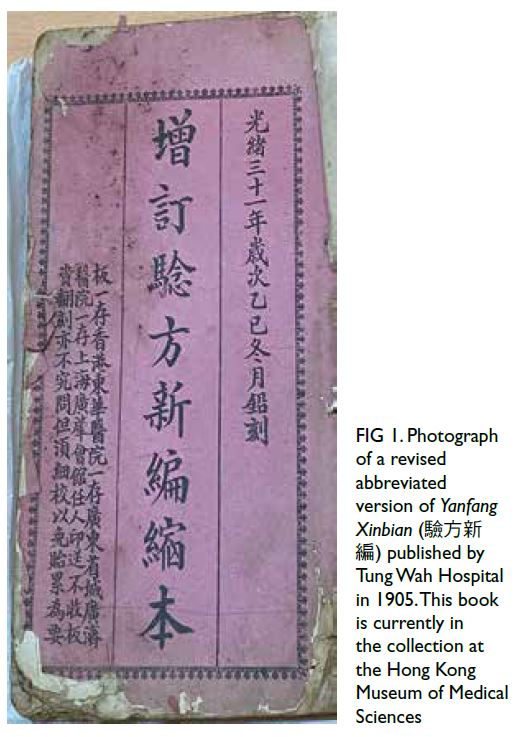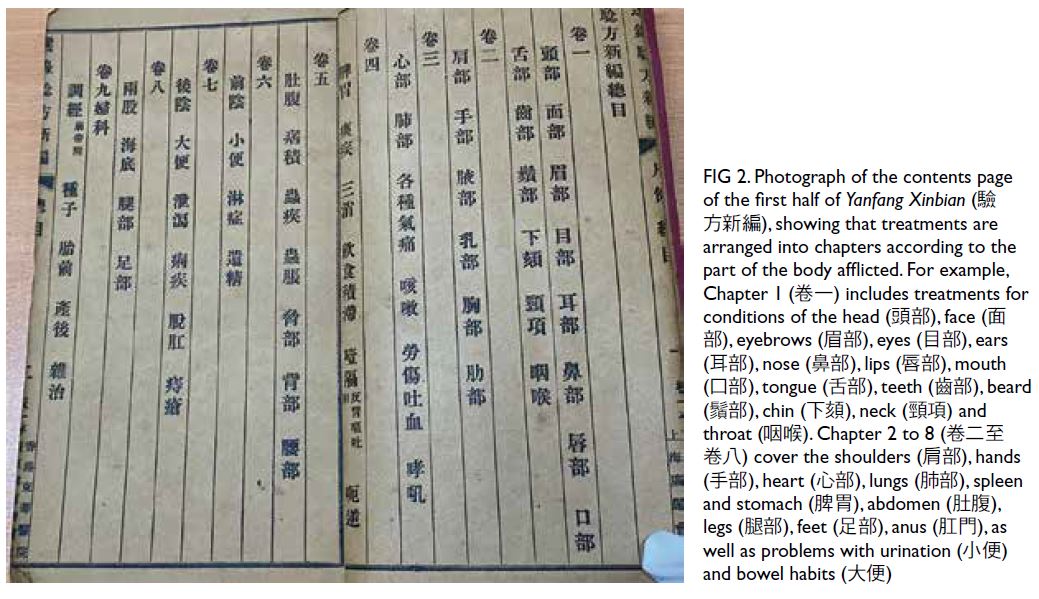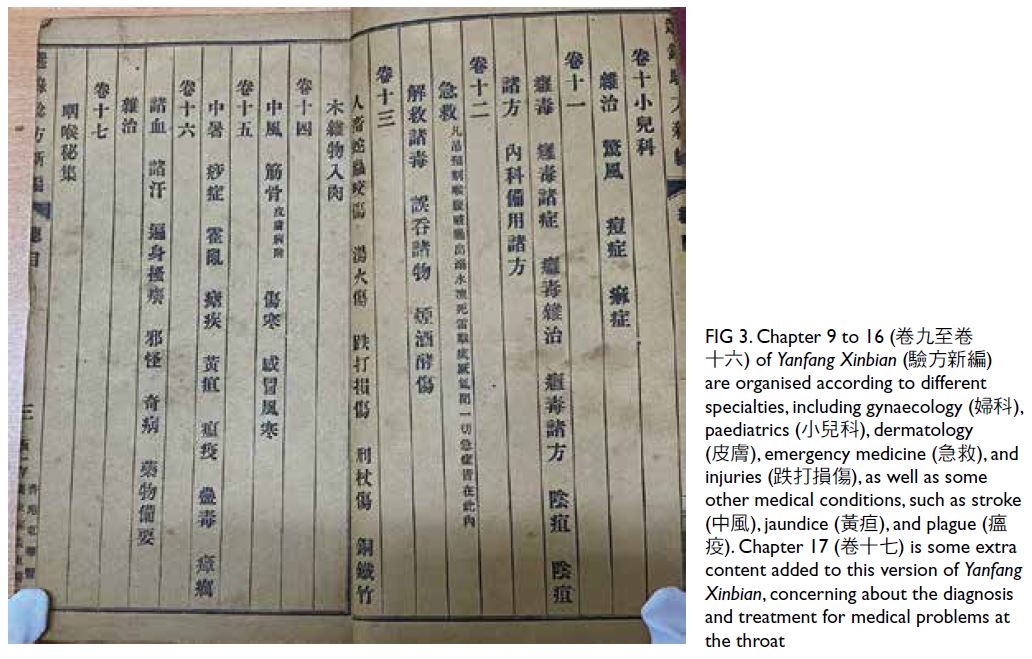© Hong Kong Academy of Medicine. CC BY-NC-ND 4.0
REMINISCENCE: ARTEFACTS FROM THE HONG KONG MUSEUM OF MEDICAL SCIENCES
Yanfang Xinbian—new compilation of
empirical formulas
Martin CK Lau, RCMP, DMed
Hong Kong Institute of Integrative Medicine, The Chinese University of Hong Kong
Guest Contributor, Education and Research Committee, Hong Kong Museum of Medical Sciences Society
Yanfang Xinbian (驗方新編) is a well-known collection of effective Chinese medicine formulas
and remedies for diseases and symptoms. A revised
abbreviated edition published by Tung Wah Hospital
in 1905 is preserved at the Hong Kong Museum of
Medical Sciences (Fig 1). The original edition was
compiled by Bao Xiang-ao (鮑相璈) in 1846.

Figure 1. Photograph of a revised abbreviated version of Yanfang Xinbian (驗方新編) published by Tung Wah Hospital in 1905. This book is currently in the collection at the Hong Kong Museum of Medical Sciences
Bao was born in Shanhua (善化, now Changsha
長沙), in Hunan Province, China, and worked as a
government official in Guangxi. Back in the 19th
century, it was not easy for people to find a doctor
for medical treatment, especially for those living
in remote areas or experiencing poverty. Since Bao
was young, he had been aware that some people
tend to keep efficacious treatment a secret, which
he disapproved of. In order to help those in need,
he thought that it would be best to spread the
knowledge about simple and effective treatment. Thus, he dedicated himself to collating efficacious
treatments for different health problems.1
After 20 years of hard work, Bao had
established a huge library of remedies for a wide
range of symptoms and diseases. From these, he
endeavoured to select the most simple, low-cost,
and efficacious treatments, and compiled them into
Yanfang Xinbian.
In the first half of the book (Chapter 1 to 8), treatments for symptoms and diseases occurring in
different parts of the body are sorted into chapters.
Readers can easily find the relevant body part
through the table of contents, including the head,
face, eyebrows, eyes, ears, nose, mouth, tongue,
teeth, throat, shoulders, hands, heart, lungs,
stomach, abdomen, legs, feet, and anus, as well as
problems with urination and bowel habits (Fig 2).

Figure 2. Photograph of the contents page of the first half of Yanfang Xinbian (驗 方新編), showing that treatments are arranged into chapters according to the part of the body afflicted. For example, Chapter 1 (卷一) includes treatments for conditions of the head (頭部), face (面 部), eyebrows (眉部), eyes (目部), ears (耳部), nose (鼻部), lips (唇部), mouth (口部), tongue (舌部), teeth (齒部), beard (鬚部), chin (下頦), neck (頸項) and throat (咽喉). Chapter 2 to 8 (卷二至 卷八) cover the shoulders (肩部), hands (手部), heart (心部), lungs (肺部), spleen and stomach (脾胃), abdomen (肚腹), legs (腿部), feet (足部), anus (肛門), as well as problems with urination (小便) and bowel habits (大便)
In the second half of the book (Chapter 9 to
16), the chapters are organised according to different
specialties, covering treatments in specialties
including gynaecology, obstetrics, paediatrics,
dermatology, emergency medicine, and injuries,
as well as some other medical conditions, such as
stroke, jaundice, and plague (Fig 3).

Figure 3. Chapter 9 to 16 (卷九至卷 十六) of Yanfang Xinbian (驗方新編) are organised according to different specialties, including gynaecology (婦科), paediatrics (小兒科), dermatology (皮膚), emergency medicine (急救), and injuries (跌打損傷), as well as some other medical conditions, such as stroke (中風), jaundice (黃疸), and plague (瘟 疫). Chapter 17 (卷十七) is some extra content added to this version of Yanfang Xinbian, concerning about the diagnosis and treatment for medical problems at the throat
Yanfang Xinbian includes a wide diversity of treatment methods, including oral medicine, topical
medication, acupuncture, moxibustion, tuina (推拿,
massage), cupping, blood-letting, guasha (刮痧),
hot bath, steam bath, and chest compression.
Various treatments are provided for each health
issue. For example, there are around 20 remedies for
indigestion of different causes. If someone feels full
after eating lychee, it is suggested to use a decoction
with lychee husk. If the indigestion is caused by
eating noodles, two remedies are offered: the first
is a cup of hot wine blended with ginger juice; the
second is a decoction with white radish juice. To
prevent indigestion, the book recommends adding
vinegar to the noodles when eating. Many formulas
and remedies in the book are very effective, and
practitioners of traditional Chinese medicine are
still using them in practice. One of the remedies
for treatment of menorrhagia (崩漏) is to apply
moxibustion at an acupoint at the big toe. This is still
one of the most commonly used acupoints in the
treatment of dysfunctional uterine bleeding.
Yanfang Xinbian was a comprehensive guide to treatment for health problems throughout the whole
body, including >6000 remedies. The book provides
a large number of formulas still used by practitioners
of traditional Chinese medicine, together with many
simple remedies for nearly any symptom or health
issue. In the opinion of some Chinese medicine experts, the content of the book may be criticised
for being too simplified and non-systematic, and
lacking the support of medical theories. However,
the information of Bao’s book was so extensive and
most of the remedies were easy to apply, so the name
and reputation of the book spread.
As time passed by, Yanfang Xinbian reached
and impressed some well-known public figures
across mainland China. They took different roles
in the promotion of the book. Some funded its
publication; some distributed it to the public for free;
some shared their high praise and recommendations
in the preface of new editions. Since the 1860s,
Yanfang Xinbian has become more widespread and
recognised not only within mainland China but
also overseas. Chinese people who travelled abroad
found it very useful, and it has also been published
in various regions, including Japan, Canada, and
Hong Kong. Between 1846 and 1949, more than
160 editions of the book were published. It is an
astonishing case in the history of medical-related
publication in China.2
The stereotype (lead printing plates) of the
revised abbreviated edition of Yanfang Xinbian was
donated to Tung Wah Hospital by the Canadian
Chinese (said to be Mexican Chinese in the preface)
Lee Mong-kow (李夢九, 1863-1924).2 3 Lee was an
interpreter in the Canadian Customs House and
Immigration Office. He devoted himself to the
promotion of education and welfare of the Chinese
community, gaining himself high reputation in
Victoria, Canada.
Yanfang Xinbian was the most widely circulated
collection of traditional Chinese medicine remedies
between the late 19th century and the early 20th
century. The purpose of the abbreviated edition
might have been for a more convenient edition to
carry while travelling.4 Lee wanted to promote the
free circulation of a reliable edition of the book and he
chose this revised and abbreviated edition. He raised funds for purchasing a set of three stereotypes and
donated them to Tung Wah Hospital in Hong Kong,
Guangji Hospital (廣濟醫院) in Guangzhou and
Kwong Siew Association (廣肇會館) in Shanghai.3
Tung Wah Hospital was founded in 1870. It
was one of the earliest Chinese medicine hospitals
and it was the first hospital of Tung Wah Group of
Hospitals. Before the establishment of Tung Wah
Hospital, most Chinese people in Hong Kong would
not go to a Western hospital or choose Western
medical treatment even when they were very ill. That
was why influential Chinese community leaders in
Hong Kong urged the government to support the
establishment of a Chinese medicine hospital. Tung
Wah Hospital has been providing Chinese medicine
in-patient and out-patient services since it was
established. The hospital has expanded its services
to other sectors, such as education, elderly services,
funeral and burial services, and other community
services.
The establishment of Tung Wah Hospital
marked a new era in providing Chinese medicine
services in a modern setting. It gained a high
reputation in southern China and overseas for
gathering the strength of the community to help
those in need. There were frequent collaborations
between Tung Wah Hospital and other charitable
organisations in Guangdong Province and overseas.
Over the years, so many people like Lee Mong-kow
were willing to contribute their wealth and influence
in enhancing the health and welfare of the community.
It is a crucial factor in the continual growth of this
oldest and largest charitable organisation in Hong
Kong.
1. 鮑相璈. 驗方新編 [in Chinese]. 序.
2. Liu XY. Spread and acceptance of popular medical readings in Modern China: a case study of new compilation of empirical formulas [in Chinese]. J Hist Sci 2020;(5):85-99.
3. 增訂驗方新編縮本 [in Chinese]. 1905; 敘.
4. Liu XY. Spread and influence of folk proved prescriptions in Jiangnan area of modern times: taking Yan Fang Xin Bian as an example [in Chinese]. Chi Med Cult 2021;16:32-40.

